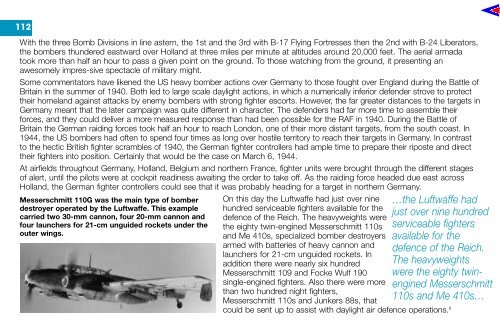THE RAF AIR POWER REVIEW - Royal Air Force Centre for Air ...
THE RAF AIR POWER REVIEW - Royal Air Force Centre for Air ...
THE RAF AIR POWER REVIEW - Royal Air Force Centre for Air ...
You also want an ePaper? Increase the reach of your titles
YUMPU automatically turns print PDFs into web optimized ePapers that Google loves.
112<br />
With the three Bomb Divisions in line astern, the 1st and the 3rd with B-17 Flying Fortresses then the 2nd with B-24 Liberators,<br />
the bombers thundered eastward over Holland at three miles per minute at altitudes around 20,000 feet. The aerial armada<br />
took more than half an hour to pass a given point on the ground. To those watching from the ground, it presenting an<br />
awesomely impres-sive spectacle of military might.<br />
Some commentators have likened the US heavy bomber actions over Germany to those fought over England during the Battle of<br />
Britain in the summer of 1940. Both led to large scale daylight actions, in which a numerically inferior defender strove to protect<br />
their homeland against attacks by enemy bombers with strong fighter escorts. However, the far greater distances to the targets in<br />
Germany meant that the later campaign was quite different in character. The defenders had far more time to assemble their<br />
<strong>for</strong>ces, and they could deliver a more measured response than had been possible <strong>for</strong> the <strong>RAF</strong> in 1940. During the Battle of<br />
Britain the German raiding <strong>for</strong>ces took half an hour to reach London, one of their more distant targets, from the south coast. In<br />
1944, the US bombers had often to spend four times as long over hostile territory to reach their targets in Germany. In contrast<br />
to the hectic British fighter scrambles of 1940, the German fighter controllers had ample time to prepare their riposte and direct<br />
their fighters into position. Certainly that would be the case on March 6, 1944.<br />
At airfields throughout Germany, Holland, Belgium and northern France, fighter units were brought through the different stages<br />
of alert, until the pilots were at cockpit readiness awaiting the order to take off. As the raiding <strong>for</strong>ce headed due east across<br />
Holland, the German fighter controllers could see that it was probably heading <strong>for</strong> a target in northern Germany.<br />
Messerschmitt 110G was the main type of bomber<br />
destroyer operated by the Luftwaffe. This example<br />
carried two 30-mm cannon, four 20-mm cannon and<br />
four launchers <strong>for</strong> 21-cm unguided rockets under the<br />
outer wings.<br />
…the Luftwaffe had<br />
just over nine hundred<br />
serviceable fighters<br />
available <strong>for</strong> the<br />
defence of the Reich.<br />
The heavyweights<br />
were the eighty twinengined<br />
Messerschmitt<br />
110s and Me 410s…<br />
On this day the Luftwaffe had just over nine<br />
hundred serviceable fighters available <strong>for</strong> the<br />
defence of the Reich. The heavyweights were<br />
the eighty twin-engined Messerschmitt 110s<br />
and Me 410s, specialized bomber destroyers<br />
armed with batteries of heavy cannon and<br />
launchers <strong>for</strong> 21-cm unguided rockets. In<br />
addition there were nearly six hundred<br />
Messerschmitt 109 and Focke Wulf 190<br />
single-engined fighters. Also there were more<br />
than two hundred night fighters,<br />
Messerschmitt 110s and Junkers 88s, that<br />
could be sent up to assist with daylight air defence operations. 8

















